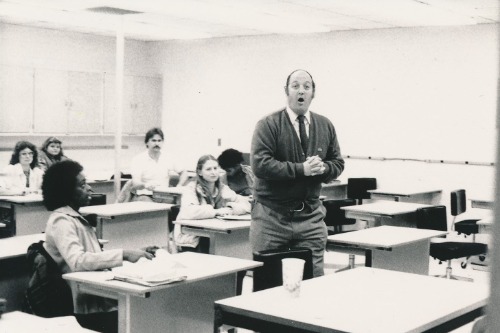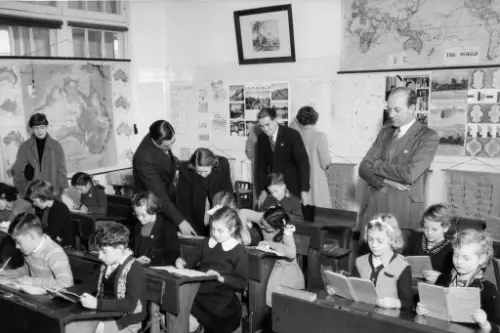1. Mandatory Pledge of Allegiance

Every morning in many U.S. public schools, students were required to stand and recite the Pledge of Allegiance, according to Brad Dress from The Hill. Some schools even tracked who didn’t stand or speak, treating it as a disciplinary issue. The pledge, originally introduced in the 1890s and modified during the Cold War, was framed as a patriotic duty. But for many students, especially immigrants or those with different beliefs, it felt more like forced conformity.
What’s strange in retrospect is how few students truly understood what they were saying—most just memorized it and recited it on autopilot. The idea of pledging loyalty to a flag every day is unheard of in most other countries. While participation is technically voluntary now, there was a time when opting out was met with suspicion or punishment. It raises real questions about autonomy and freedom of thought, especially in an educational setting.
2. Dress Codes That Targeted Girls

Many U.S. schools enforced strict dress codes that seemed to apply way more harshly to girls than boys, according to Patty Inglish from HubPages. Rules like “no spaghetti straps,” “no visible bra straps,” and the infamous “fingertip rule” for shorts length were common. The justification was usually that it would “prevent distractions,” which essentially placed the burden of male focus on young girls. That message sticks with people longer than schools probably ever realized.
These dress codes often resulted in girls being pulled out of class for minor infractions, missing lessons over a shoulder or knee. In hindsight, it’s pretty obvious how this policy could be both sexist and disruptive to education. Many former students have spoken out about how shamed or embarrassed they felt for something as innocent as wearing shorts on a hot day. It’s a rule that not only seems outdated now—it probably never made sense to begin with.
3. No Talking at Lunch

In some U.S. elementary and middle schools, kids were literally banned from talking during lunch. Not just discouraged—full-on silent lunch policies were enforced, sometimes with color-coded cups or warning cards to keep track of noise levels. The idea was to maintain order and prevent food fights, but it often felt more like a punishment than a rule. For a lot of students, it turned what should’ve been a fun break into just another part of the school day to endure.
Looking back, it’s wild that socializing—something kids naturally need—was treated like a disruption. Plenty of adults today still remember nervously whispering with friends and getting busted for giggling over peanut butter sandwiches. And while some schools argued that it helped manage rowdy cafeterias, the emotional toll it took on shy or talkative kids wasn’t often considered. In retrospect, it seems more like a control tactic than an educational one.
4. Punishments for Left-Handed Students

Being left-handed was often seen as a defect for years, and many schools tried to “correct” it, according to Lily Rothman from TIME Magazine. Teachers would force left-handed students to write with their right hand, sometimes even tying their left hand behind their back. This practice was based on outdated beliefs that left-handedness was associated with disobedience or even sinister tendencies. Some students developed long-term difficulties with handwriting and coordination due to these forced changes.
Modern science has since debunked these myths, and left-handedness is now recognized as a natural variation. The idea of punishing a child for their dominant hand would be seen as absurd and abusive today. Schools now provide left-handed desks and materials to accommodate students rather than trying to change them. Looking back, this practice highlights how deeply ingrained superstitions once influenced school policies.
5. Corporal Punishment Was Commonplace

Spanking, paddling, and other forms of physical punishment were standard disciplinary measures in the 1950s, according to Elizabeth T. Gershoff and Sarah A. Font from the NIH. Teachers and principals had the authority to strike students for infractions like speaking out of turn, forgetting homework, or minor misbehavior. Many believed that physical discipline instilled respect and obedience, and parents often supported the practice. However, this approach frequently led to humiliation, fear, and resentment among students.
Today, corporal punishment has been banned in most American schools, with research showing its harmful effects on children. Educators now emphasize positive reinforcement and conflict resolution instead of physical discipline. The shift reflects a broader understanding of child psychology and the importance of fostering a supportive learning environment. If a teacher today were to use corporal punishment, it would likely result in immediate dismissal and legal consequences.
6. Segregation in Schools

Despite the Supreme Court’s landmark 1954 ruling in Brown v. Board of Education, many American schools remained segregated well into the 1950s and 60s, according to Yale University. In parts of the South, Black and white students were still taught in separate classrooms, used different facilities, and had unequal access to resources. Some schools resisted integration by implementing stalling tactics, like closing public schools altogether or creating private academies for white students. Even in areas where integration was technically allowed, de facto segregation persisted due to housing policies and local resistance.
This blatant racial discrimination would be unthinkable today, as laws now require schools to provide equal opportunities regardless of race. However, the legacy of segregation still lingers in educational disparities across the country. Schools today strive to promote diversity and inclusion, recognizing the immense harm caused by past segregation policies. The fight for educational equity continues, but the forced separation of students based on race is now universally condemned.
7. Banning Backpacks in Classrooms

In some districts, schools banned students from bringing backpacks into classrooms, citing safety or cheating concerns. The theory was that bags could hide contraband and harmful objects or allow students to sneak in notes or phones during tests. So instead, kids had to carry armfuls of books and supplies from class to class, like academic pack mules. It made passing periods chaotic and cluttered, especially in crowded hallways.
The logic behind this rule was a mix of fear and micromanagement, but it didn’t exactly make life easier for students. Many ended up with back problems or just constantly stressed from juggling everything between classes. While it was meant to maintain control, it often created more issues than it solved. Looking back, it’s hard to see how this helped learning in any meaningful way.
8. “No Girls on the Playground During Boys’ Games”

In many schools, girls were not allowed to participate in contact sports like football or baseball. Schools often designated separate, less physically intense activities for girls, such as cheerleading or dance. The belief was that girls were too delicate for rough play, reinforcing outdated gender stereotypes. Some schools even had separate gym classes with completely different curriculums for boys and girls.
Modern education has largely abandoned these restrictive policies in favor of equal opportunities in sports. Title IX, passed in 1972, ensured that girls had the same access to athletic programs as boys. Today, female students compete in every major sport, from wrestling to basketball, proving that athletic ability is not limited by gender. Looking back, the exclusion of girls from certain sports seems not just unfair but completely arbitrary.
9. Physical Education Participation Was Mandatory, But Only for Some

Physical education was a requirement in most 1950s schools, but boys and girls often had very different expectations. While boys participated in rigorous activities like push-ups, sprinting, and competitive sports, girls were often limited to light stretching, dance, or calisthenics. Some schools even excused girls from strenuous exercise altogether, reinforcing the idea that physical strength was only necessary for boys. These differences sent a clear message about gender roles and expectations.
Today, physical education programs are much more inclusive and balanced. Both boys and girls are encouraged to participate in a wide range of physical activities, with an emphasis on fitness and personal growth. Schools recognize the importance of physical activity for all students, regardless of gender. The days of assuming girls couldn’t handle exercise are long gone, replaced by an understanding that everyone benefits from staying active.
10. Long Hair Rules for Boys

Many schools used to enforce strict hair-length regulations for boys, requiring them to keep their hair short and neatly groomed. Long hair was associated with rebellion, delinquency, and countercultural movements, even though the hippie era hadn’t fully arrived yet. Some schools went so far as to conduct regular hair inspections, sending boys home if their hair was deemed too long. This rule was often justified under the pretense of maintaining discipline and ensuring that students looked “respectable.”
Modern attitudes toward personal appearance have changed dramatically, making such rules seem unnecessary and oppressive. Today, students are generally free to wear their hair however they choose, as long as it doesn’t interfere with learning. Long hair on boys is no longer seen as a sign of rebellion, and many schools have relaxed their grooming policies to respect personal expression. If a school tried to enforce strict hair-length rules today, it would likely face significant backlash from students and parents alike.
11. Strict No-Piercing Policies

For decades, many schools outright banned piercings, even small stud earrings on girls. The prevailing belief was that body piercings were inappropriate for young people and were associated with nonconformity. Any student who showed up with pierced ears could face disciplinary action, and in some cases, they were required to remove their earrings entirely. This rule reflected broader societal norms, where even adult women were sometimes discouraged from wearing noticeable piercings.
Today, piercings are widely accepted as a form of personal expression. Many schools allow students to wear earrings and even other facial piercings, as long as they are not disruptive. The idea that a tiny stud earring could impact a student’s education now seems outdated and unnecessary. With growing cultural acceptance of body modifications, strict anti-piercing rules have largely disappeared from school policies.
12. Teachers Were Allowed to Control Bathroom Access

A lot of U.S. schools had strict policies about when students could use the bathroom—sometimes limiting it to a certain number of passes per semester. If you used them up, you were out of luck, even if you really had to go. Some teachers even implemented “bathroom logs” or required you to find someone to “cover for you” before leaving. It turned a basic human need into a bureaucratic challenge.
These rules often ignored medical needs or the unpredictability of, well, nature. Students would suffer in silence or even have accidents rather than face punishment or embarrassment. It’s baffling in retrospect that bodily autonomy was so tightly controlled in a learning environment. Fortunately, many schools have begun loosening these rules, but not before leaving some pretty awkward memories behind.
13. Standardized Testing Obsession

While tests exist everywhere, the U.S. took standardized testing to another level, especially after the No Child Left Behind Act in 2001. Schools were graded, funded, and even punished based on how students performed on these tests. As a result, some classrooms became test-prep factories, sidelining creativity and deeper learning. “Teaching to the test” became the norm in countless districts.
This rule wasn’t officially in the handbook, but the pressure it created shaped every part of school culture. Recess was cut, arts programs were dropped, and students were overwhelmed by constant assessments. Looking back, it’s clear that the overemphasis on standardized testing often hurt more than it helped. Education became about numbers, not knowledge.


